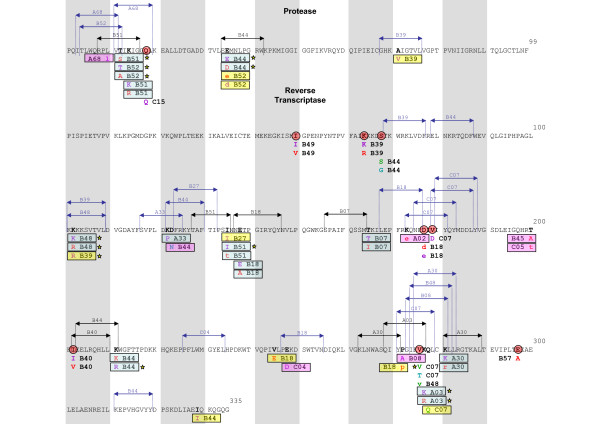Figure 6.
Epitope map supporting HLA-HIV polymorphism associations obtained by the Phylogenetic Dependency Network model in the Mexican cohort. HLA-HIV polymorphism associations were searched in pol sequences derived from 280 individuals from Central/Southern Mexico using the previously described PDN model [14] that corrects for the confounding effects of HIV phylogeny, HIV codon covariation, and linkage disequilibrium of HLA alleles. Significant HLA-HIV polymorphism associations (q < 0.2) were located in an epitope map. Strongly significant associations (q < 0.05) are marked with yellow stars. Experimentally defined CTL epitopes are shown in black http://www.hiv.lanl.gov/content/immunology/index.html, epitopes predicted by HLA peptide binding motifs are shown in blue (Motif Scan, Los Alamos HIV Database, http://www.hiv.lanl.gov/content/immunology/tools-links.html ). Target HIV positions are shown in bold, including the predictor HLA allele and the associated amino acid residue in different colors depending on the type of leaf distribution of the association obtained with the PDN model, i.e. escape (purple; having the predictor HLA makes it less likely to have the target amino acid), attraction (red; having the predictor HLA makes it more likely to have the target amino acid), reversion (green, not having the predictor HLA makes it more likely to have the target amino acid), repulsion (light blue; not having the predictor HLA makes it less likely to have the target amino acid). Amino acids in lower case indicate associations obtained without considering codon covariation. HLA-HIV polymorphism associations in the Mexican cohort were compared to the ones observed in the multicenter IHAC cohort including 1845 individuals from British Columbia, Canada, the USA and Western Australia [37] (Brumme ZL, John M, et al, PLoS ONE 2009, in press). Shared associations between the Mexican and IHAC cohorts are shown in blue rectangles; shared target HIV positions with shared target amino acids that were associated with different predictor HLA alleles in each cohort are shown in yellow rectangles; shared target positions with different HLA predictors and different associated target amino acids are shown in pink rectangles. HLA-associated HIV positions observed exclusively in the Mexican cohort are marked with red circles.

